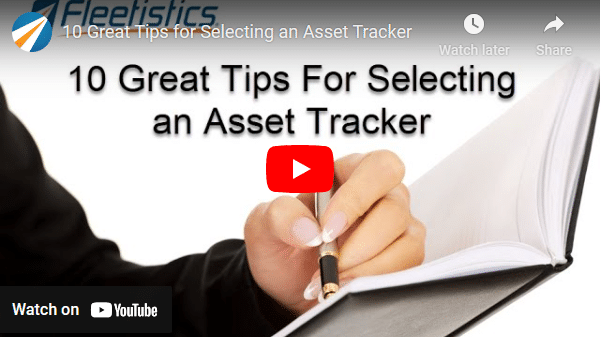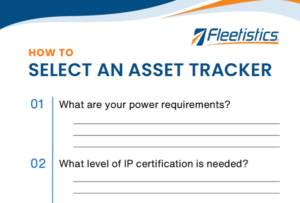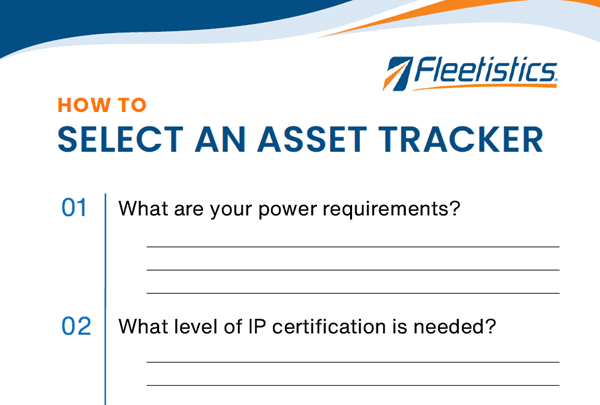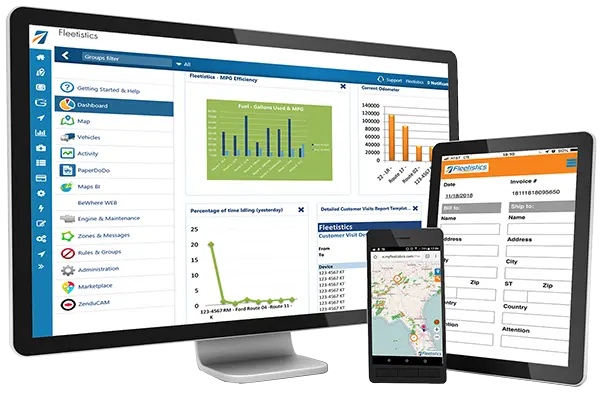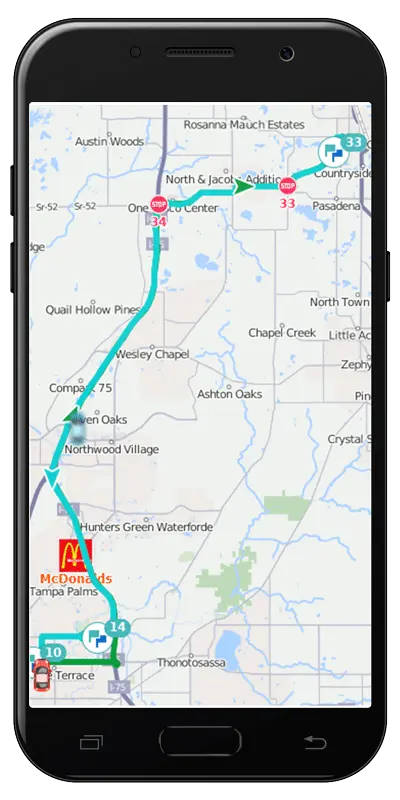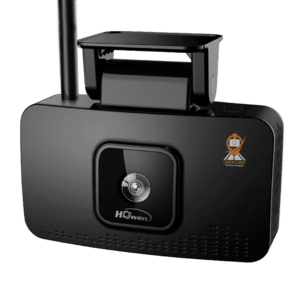Selecting an Asset Tracker
There is much to consider when choosing an asset tracker. In the video and transcript below, we highlight 10 critical considerations and provide a checklist to help you make the best possible decision.
Transcript Introduction
Hey, everybody. Eron from Fleetstics, and today we’re going to be going over what you need to know about buying an asset tracker. There’s actually a lot of considerations that go into this decision to find the right solution that’s going to give you the best return on investment. And we’re going to run through this quickly because there’s actually quite a few things that you need to be thinking about.
And you’ll be able to download this list from our website. We’ll post the URL up in the video as well as put it in the notes below. And you can click that link and go get the list and download it. And you know, basically use it as a checklist as you go and look at different devices, check the check the box off, see what different devices do and how they do it based on the criteria that you’ve established as being important for what you’re trying to get accomplished.
Get industry tips and insights
Sign up for monthly news and tips from our award-winning fleet management blog. You can unsubscribe at any time.
Other posts you might like
Download the checklist for Selecting an Asset Tracker using the form below.
Complete the form below or call 855.300.0527
Power Consumption and Environmental Considerations when Selecting an Asset Tracker
So, the very first thing is you know how much power is going to be available. Is it strictly a a situation where power is available all the time, which is always ideal? If it’s an unpowered asset, is it something that can be solar powered? Or is it best to have some kind of combination where it gets power sometimes, but then it may sit for a long period of time and not get any power.
So, it needs a battery backup or potentially a solar panel to recharge the backup battery so it can be out for extended periods of time. When you’re talking about solar though, you’ve got to be very aware of the environmental conditions because you know, in the southern states that tends to work fine.
In the northern states, when it snows for extended periods of time, where you get a little cloudy periods for weeks on end, then that recharging may not take place. So, you need a battery that’s going to be effective for the periods at which that may not be accessible.
One of the things to consider when mounting a solar device is mounted vertical. You know, if you lay it flat on top of a trailer in the winter, it’s going to get covered in snow and ice and it won’t recharge whatsoever. Plus, when the ice sheet falls off the top of the truck, you can very easily take the, you know, the tracking unit with it as well.
So put it someplace where it’s vertical. When it rains, it gets washed. When it snows, it tends to fall and clean itself when the snow melts.
All right, So what level of IP certification is required? Do you need something that is mil spec, right? Do you need something that is that rugged? Every asset tracker should be, you know, rugged to some degree, but not everything is built to mil spec. You know, like the Global Star Smart one device that we have, it’s solar with a big battery pack in it and it’s built for the military and satellite communication, right?
That’s a little bit more expensive, but the plus side is you don’t replace them as often and they last, you know, you’re not chasing batteries. They’ll recharge better, they’ll perform better.
What happens a lot of the time is with, you know, trackers on the outside that are not to mill spec and you know, they people are washing their trucks or whatever and they’re pressure washing. They get the pressure washer too close. You’re not supposed to pressure wash any of the external asset trackers with less than like 2 meters, right? The jet is too strong and it can go in through the seals and end up inside the device and you end up having rust problems which is not going to be covered by the warranty.
Next is how long do you need to how long do you need that asset tracker to operate without power? Kind of mentioned that before. Is it a trailer that sits in the yard and it moves on occasion, but not that often. So, one update per day is fine.
There are disposable battery devices that will go 5 and 10 years if they’re only doing 1 update per day, so that may work for you if you’re just trying to do an inventory solution, but a lot of times when they’re sitting still, that’s great.
But as soon as they start to move, they can be programmed to update a little bit more frequently. And then you have to start doing the math as to how long the battery will last once the trailer is being moved, based on how much it is being moved.
And then decide, you know, all right, well, it’s advertised 10 years. If I do it once a day, but that trailer moves every other day and it moves 100 miles and it updates every 15 minutes, that’s going to be X number of GPS points per day. So how many from the total should I subtract? And then that’ll kind of tell you how long the battery’s going to last.
And if you have a rechargeable situation there, then obviously that recovers and then stays out longer. So solar just typically really ends up being less hassle in the long run because you don’t have to worry about the batteries. You know, the ones that you take and throw away once they’re dead.
They’re fine for a lot of applications, but you just need to think about what is that application and can you get to that asset in order to make that device swap.
You know what you don’t want to do is have a device go dead before the battery before you get a chance to swap it or swap the batteries out because then if the asset moves and the batteries are dead, you don’t know where it went right?
Next is, do you need satellite or cellular communication? This is important. 95% of the population lives within cell phone coverage, right? It’s usually along the coast, major cities, things like that.
If you’re operating within those areas, then you know cellular communication is going to work fine for you. Cellular communication penetrates better. It’s not as sensitive to environmental conditions compared to satellite, but you are limited to cell towers, right. And there’s a balance here.
You’ve got to balance, you know, communication versus cost. You know, how much data do I want to get over what geographic area and what am I willing to pay to get it?
You know, satellite communication, you know, and there’s different types of satellite constellations too. You’ve got ones that stay in place as though as the Earth turns, then you’ve got ones that spin around and then another satellite comes by and then, you know, you pick one up, drop one, pick one up and drop one. And they perform differently.
And depending on your level of access required and where you are in the world will determine what type of satellite constellation you need to be considering for your tracking. But satellite trackers are very sensitive to environmental conditions. Line of sight is a big deal. You know any kind of tree cover, buildings, anything like that satellite communication is just not going to work.
Cellular communication, if you think about, you’re in your car, you’re in your house, you’re in a building, you can make cell phone calls from anywhere. The difference between satellite and cellular is that communication penetration in the coverage footprint that you get. Satellite communication is also a lot more expensive.
If you looked at it just as an analogy, one data point on a satellite device might cost you a dollar, on cellular it might cost you a nickel. So, there’s a big cost differential. You’re not going to get the detail that you are used to seeing from a cellular system on a satellite system. Next is based on the intended installation location, what type of communication is needed so that that comes into play, satellite or cellular.
If you’re trying to do covert right and you’re going to try to put something up underneath the trailer has to be cellular, right? Satellite is not going to reflect off the ground. Cellular will reflect off the ground and penetrate through the deck and things like that.
So, there are situations where there’s mobile generators that are used for disaster response. Those mobile generators have steel housings around them, and putting a device inside of that creates problems even for cellular communication.
So, you’ve got to be smart about where to put the device and you’ve got to hedge your bets. Everything is give and take in life, as you know. But if I put it on the outside and I mount it on the face, I’m going to get the optimum performance, but I may not get the theft protection.
If I mount it underneath, I’m going to lose performance, but I would get theft protection. If I mounted inside, I’m going to lose performance but maybe get theft protection. So those are the decisions that you need to make and come up with and maybe some testing is a good idea.
But it really comes down to what are your objectives for your asset trackers. If you have a big theft problem, then covert installation is going to take priority over perhaps you know performance. So, think about that and decide what’s going to be best for you.
We talked about how accessible the device needs to be to change batteries, right? We’ve had customers that have had devices that have batteries in them. They don’t pay attention to them. The batteries die, the asset moves. They don’t know where it is. You know, they start chasing AA batteries. They’re trying to replace $15.00 worth of batteries and they’re spending hundreds of dollars in man hours of drive time and labor to, you know, to go out and replace $15.00 worth of batteries.
We don’t recommend battery only solutions where you got to swap the batteries. If you’re going to do that, just think you know really what’s best long term. One trip to the field with payroll, fuel, wear and tear, rolling cost per mile in your vehicle and things like that to swap batteries on five of the, you know, 25 devices that need to get swapped that day or that are low on battery today.
And maybe you’ve got another dozen that are low next week or next month and you’ve got to come back and repeat that process. It’s a huge waste of money. Some people still make that decision. We just don’t recommend it, right? Do something that you’re going to be as hands off as possible for as long as possible with a technology that’s going to meet your objectives.
Additional Considerations when Selecting an Asset Tracker
All right. So next is will your asset ever leave the USA. You know, are you going to be using different, different cellular carriers. You know, if you go outside the country and if you are, you need to make sure that you have a carrier for the device that is going to allow the roaming, let’s say between the United States and Canada. You know, make sure that you understand the technology will roam and that there’s no additional charges for that.
It might be US and Mexico, which all three countries pretty much have a good situation. But if you’re outside the United, you know like North America and you’re in Europe, maybe there’s some outlying countries that have different carrier networks and they’re not cross compatible or they’re not going to transition over, then you know you might lose visibility on an asset if it goes into another country.
All right. Next is will the asset tracker integrate with your vehicle tracking system today? The answer is yes. In most cases. There are still lots of trackers that are out there that operate independent of any specific system. Most of those can be relatively, I won’t say easily integrated, but they can be integrated with other systems.
There’s actually a lot that goes into, you know, getting the data from a cell carrier and then parsing it, making it go where you want, understanding if you’re trying to divide it into different accounts and how to read the data strings and things like that. It’s been done for a while now, but it is not an easy task to manage that at scale. So, think about that aspect of it.
You know, buying something that is integrated into the vehicle tracking system that you already have makes sense unless you don’t want to be beholding to a single vendor for vehicle and asset tracking. Sometimes you know it’s best not to put all your eggs in one basket.
Sometimes it is because you’re really comfortable with the solution, you trust the company and you know that they’re going to do good things for you long term and having an integrated solution just makes your life easier for the foreseeable future.
Next is understanding what is the warranty, what’s covered, what’s not right, how’s that process going to be handled when something goes wrong? Invariably technology is what it is. Everything’s going to have a failure rate, you know, hopefully less than about 1% would be ideal.
But asset trackers can be heavily abused depending on what application they’re in. You know, installing stuff in yellow iron, if it’s encased inside the housing of the bulldozer, whatever, or in the cabin the bulldozer. Relatively good environment, right? Pretty much protected the where the driver is.
You know that the environment for a driver is very conducive to, you know, long lasting electronics. You take that same device, you put it on the outside, now it’s baking in the, you know, the Arizona sun at 130°. You know that device is not going to last as long, and you need to understand these things because you have to have a mentality of this is temporary technology.
Eventually you’re going to have to replace it. You’re going to have to upgrade it. You’re going to have to swap it out because it’s going to stop working. Don’t think it’s going to last, you know, 15 years because these devices just aren’t going to last that long. The plastic degrades in the sun after you know 5 plus years.
I mean we’ve had customers that have been using the same tracker for seven or eight years, but you know, depending on the environment and we’re talking about asset trackers here. So, it’s going to be different for asset trackers, all right.
How long is the warranty? How do you prove you know what the situation is? What’s the troubleshooting process? You know if you go through that troubleshooting process and you send it back, what’s the process for getting it back? How long is it going to take to get the device back? A replacement device in? Are you getting the same device? Are you getting a like device? Are you getting a pre-owned device? You know, all of those are good questions to ask.
Most of the time you’re probably going to get a pre-owned device, maybe something that came back in as long as it meets the warranty requirements and goes back under warranty to get you through the warranty. That’s ultimately the commitment from the vendor. If there’s not any, you know, pre-owned hardware that’s been returned and repurposed, then you know you’ll obviously get a new device.
Understand if there’s a cost to test device that ends up being out of warranty, you know, so there is a real cost to us as telematics vendors, when equipment gets sent back to us and the customer didn’t go through the troubleshooting process, they just like, oh, I’m too busy for this, I’m gonna send it back. All right. Well, now shipping’s involved, Labor’s involved.
And oftentimes a customer says, hey, I want a unit before I send you this one back. And then we get a piece of hardware back and it ends up being a working piece of hardware. And now we can’t sell that unit at new prices. So, we’ve got to discount it.
So, all of that ends up resulting in a fee to the customer, which is pretty reasonable. I mean, you can’t think of any other electronic device that doesn’t have that general type of policy. You mean you certainly can’t do A TV or a computer or things of that nature without those types of fees if what you return actually works. So, it does behoove you to understand what the testing process is and have someone that is well suited for that process.
Most of the time the testing only takes about 5 minutes. You can Simply put it in another vehicle and run it over there and if it works, then hey, you’re great.
If you’ve got a big enough fleet, you might do like I do. I’ve got three wires hooked up in my vehicle in my glove box that I, you know, I use for routine testing. I get a device that I’m curious about, either a new device that we want to explore or, you know, we get a handful of devices back and we need to start doing some internal testing. I can just hook them up and put them in my glove box, go for a drive.
If it works in my vehicle, you know the device isn’t bad. There’s something wrong on the customer’s vehicle, so that troubleshooting process is relatively quick and easy.
What documentation is available for troubleshooting? There are online videos, which is great. You know, if your video doesn’t exist, you could easily ask the vendor to create a video for you so you can watch the process and someone can talk you through it.
We’ve done that not only for regular devices, but if a customer has a unique installation, then we can create a video for that particular customer. That’s going to resonate very directly with any employees that might be doing that service work or even installation contractors that need to understand something unique about a particular install.
And then how long is the service agreement on that device. Service agreements do a couple things. They establish expectations for you, for the vendor, they outline the rules of the game, right, and it allows us as vendors to subsidize the cost of the equipment, right. If we had to bill one time for a real-time tracking service, we would have to exponentially increase the cost and by having a service agreement and a guarantee of income over a period of time then we can subsidize the cost of that equipment. It’s no different than any other business.
That’s the list. Hopefully it’s going to be helpful at least trigger you to think about some things. But number one is make a list of the you know the top three to five things that you must have in a tracker in an asset tracker. And if you can’t get those things, whatever they are, then simply eliminate that device as a possible solution to your to your goals, right?
If you make the list beyond three to five things, you’re going to eliminate everything because no device does it. All right, so keep the list short of the things that you must have and then make a list of the things that you would like to have. And on that list, you know, make it as long as you want.
And then if you get your must haves and then twenty of your like to haves compared to 15 of your like to haves for a different product, then you know, all right, hey, this one’s going to give us the biggest bang for the buck, not only today, but as we move into the future and we want to do different things with the data that we’re able to collect.
So hopefully this helps. If you appreciate the video and the content, please hit the like button.
Consider subscribing to the Fleetistics Channel and we’ll see you on the next video.
Thank you and have a great day.







